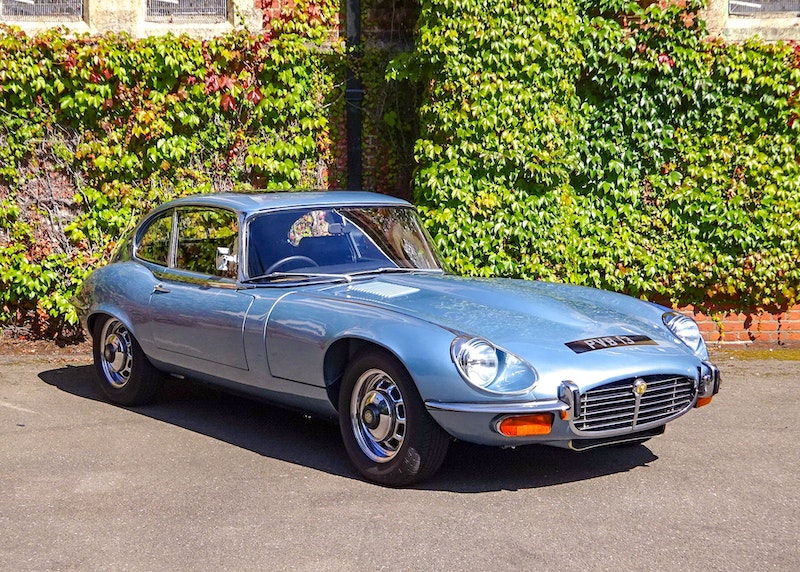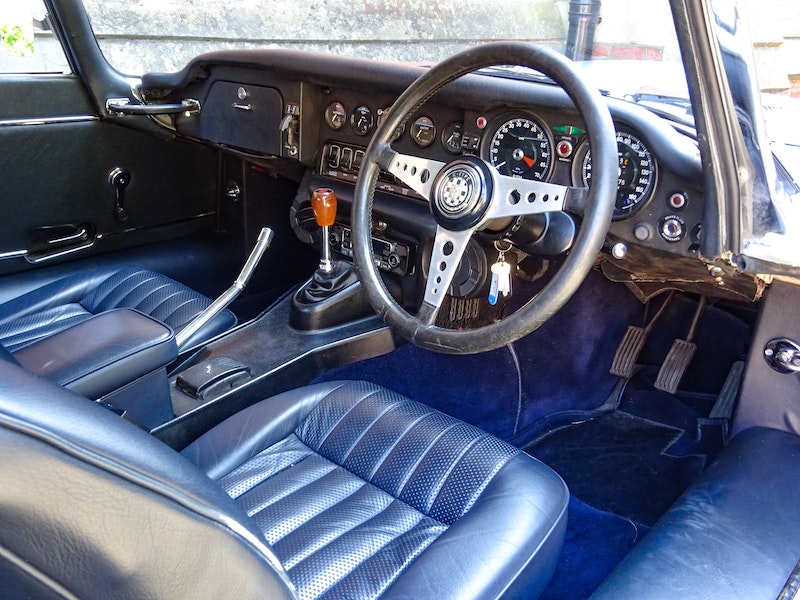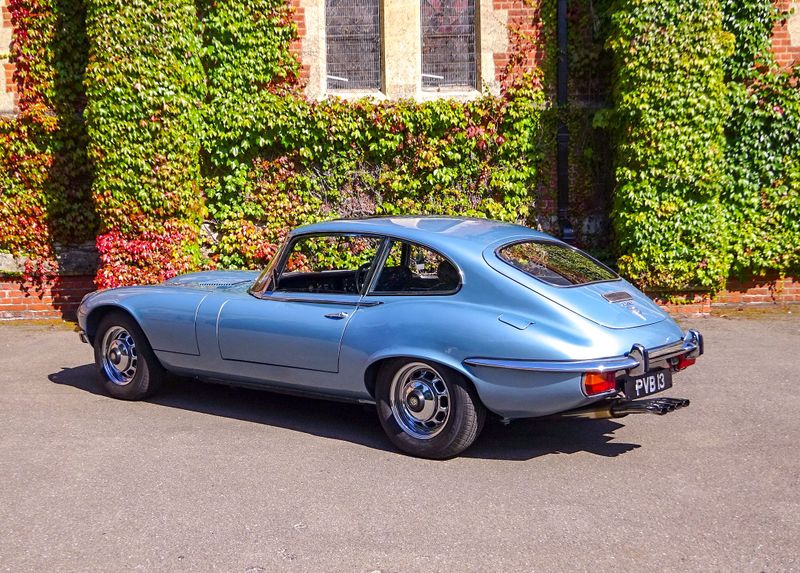Highlights
- Believed to be one of three official press cars built in 1970 for the 1971 launch
- Chassis 003 - the third Series III E-Type 2+2 built
- Full body, chassis and mechanical rebuild
- Exempt, but a fresh MoT awaits new keeper
- No expense spared on maintenance and upkeep
- 5 Speed manual gearbox
- Cherished number included in sale
The Appeal
More than six decades on, the Jaguar E-Type still ignites passions, just as it did when first revealed to the public at the 1961 Geneva Motor Show. When launched, there really was nothing else quite like it.
A bonnet that ‘went on forever’ and muscular engines with ‘longer legs than Twiggy’, the Jaguar E-Type is one of a rare handful of cars that will always get hearts pumping…and opinions flying.
When new, this Series III 2+2 Coupé fitted with Jaguar’s V12 powerplant delivered Ferrari-beating performance for half the price. That alone would have been enough to sell this third-generation E-Type in droves, but what really made this British icon an automotive legend, was its looks.
For the Series III E-Type Jaguar, the short wheelbase FHC (fixed head coupé) body style was discontinued and was available only as a Convertible (OTS – open top two-seater) and 2+2 Coupé. Both rode on a longer wheelbase chassis which offered considerably more interior space.
Now, after a mechanical rebuild in 2017 and a full body restoration commenced in 2020 (and which continued up until just last month), the appeal of this sleek, opalescent silver blue Jaguar E-Type Series III is greater than ever – and hopefully not just on Sundays.
History and Paperwork
- One of three built in late 1970 prior to early 1971 launch
- Low mileage and low ownership
- Dry-driven, housed in purpose-built storage facility
- V5c in current keeper’s name
According to the Heritage Certificate, this Jaguar (Chassis #IS 50003) was built in August, 1970 and was one of three cars believed to have been built for the official Series III press launch, prior to the model going on sale in early 1971. This car was first registered to Jaguar Cars in February, 1971, receiving its original registration mark of WHP 675J.
Indeed, it may well have been this very car that was road-tested for ‘Jaguar Driver’, the magazine of the Jaguar Drivers' Club – the only owners club to be officially sanctioned by Sir William Lyons and Jaguar themselves. The road test of a car provided by Jaguar was published ahead of all the national and international magazines at the time.
Following the media launch and with production well underway in early 1971, this Jaguar was promptly dispatched to Coombs Jaguar of Guildford. The Jaguar was enjoyed by just five former keepers until it was acquired by its current keeper in 2013, after which its future became considerably brighter.
Originally ‘Old English White’ in colour, the car was given its new striking colour of ‘Opalescent Silver Blue’ it wears today. At that time and also by Lanes Cars of Walsall, some engine work was carried out, a five-speed gearbox more suited to GT cruising replaced the original four-speed unit, the steel wheels were chromed and a sunroof, inertia-reel front seatbelts, radio and air conditioning were fitted to the car. Following those works, the car was then registered in the current keeper’s name recording its new colour. Its private plate of PVB 13 will accompany the car.
In 2017, the engine and gearbox were overhauled and a new windscreen fitted by Southern Classics of Twickenham. Work to the value of over £20,000 was invoiced.
In 2020, more work was assigned to the interior trim and body (see gallery), amounting to a further £15,600. Only last month, the final body works were carried out to replace the passenger side floor and sill.
Accompanying the sale will be a treasure trove of restorative images, videos and invoices detailing the works carried out over the years. Some of the numerous images are replicated in the accompanying gallery. A fresh MoT and the V5c in the current keeper’s name are also available.
The Interior
- Elegant blue leather upholstery
- Tidy and largely original
- A few convenient nods to modernity
Prior to its refit, the original interior was in rather a tired state so the decision was made to retain and recommission trim parts where able. Fortunately, the dashboard was the best part of the original interior so was retained largely unscathed, along with the drilled three-spoke steering wheel.
The leather interior was regenerated and moisturised as were the door cards and rear side panels. The carpets are in good condition throughout the floorpan and the headlining presents in equally good condition. Overall, it’s rather smart and a great place to while away some B-road time or coastal cruising.
While somewhat removed from concours, the interior presents in ‘lovingly used’ condition. There is slight wear to the right of the driver’s seat as pictured and a few blemishes here and there, but little than should concern any Jaguar enthusiast.
The Exterior
- Stunningly presented in Opalescent Silver Blue’
- Brightwork is in exceptional order
- Bodywork not far removed from concours
- Recent spend of £6500 on bodywork to treat rust
Following its external regeneration, the condition of the exterior of this Jaguar is simply stunning and is indicative of the love and care afforded the car by its current keeper since its acquisition almost 10 years ago.
The strikingly beautiful colour radiates in the sunshine, the light lenses front and rear are clear and the plastic lens covers show no hint of fogging that may sometimes be associated with a car of this age.
The front and rear bumpers are in remarkable condition and largely blemish-free, although there is a small amount of pitting in areas which, some say adds to the patina. The chromed steel wheels show no scuffs or evidence of being ‘curbed’ and wear their bespoke chromed hubcaps well. They are currently shod with a good set of tyres.
The brightwork around the car – and there is much of it on a car of this vintage – is in exceptional condition, none of which has a scratch or mark to its surface that we could see. A cursory glance down each flank of the car shows no evidence of collision damage. All apertures open and close smoothly and as intended.
Since the time of photography, it has been treated to £6500 worth of work on the sills, arches and floor to take care of some corrosion.
Some updated photos of the repaired areas are viewable in the gallery below.
The Mechanics
- Complete mechanical refurbishment in recent years
- Fully maintained, no expense spared
- The V12 purrs like a…well, cat!
- A 12-month MoT awaits the new keeper prior to handover
- New battery
Our writer and photographer was rather fortunate to have been driven in the Jaguar several miles to the photo location – and the experience was epic to say the least! The chunky V12 fired up at the first ask every time and settled into an appreciative burble that only a well-maintained twelve-pot can make. The gearbox connected smoothly and the drivetrain engaged with no drama, requiring a just gentle rev to get underway.
With significant mechanical work undertaken in recent years, the custodian reports the car to be in very good mechanical condition with steering, brakes, engine, drivetrain and running gear performing as well as their respective British engineers intended over fifty years ago.
The engine bay is very tidy and clean and, like the immediately visible parts of this Jaguar, the underside of the car presents in good order with little of the natural oxidation that may reasonably be expected on a car of this vintage.
Summary
Popular automotive culture suggests that, on its release on 15th March 1961, Enzo Ferrari called the Jaguar E-Type "the most beautiful car ever made", which was high praise indeed for its chief designer Malcolm Sayer. The coupe’s long flowing bonnet, gorgeous proportions and powerful engine made it a game-changer in the early 60s.
There are a number of Jaguar E-Types on the market at any one time in all its available body styles from all three generations manufactured from 1961 to 1974. However, not many have received a level of restorative TLC to both body and mechanicals as PVB 13 during recent years.
Presented in stunning opalescent silver blue and regenerated to live a further few decades out on the open road, it is hoped that the new keeper of this British automotive icon will care for it in the manner to which it has evidently become recently accustomed. Indeed, there is little doubt that the car will serve its new owner well for many years to come…and not just on Sundays.
Notice to bidders
All items in this listing are sold on an “As Is - Where Is” basis. Photos and listing descriptions should be used as a guide only. Although every effort has been made to verify the accuracy of the information in this listing and Car & Classic performs a level of due diligence prior to the auction, we do not warrant the accuracy of the listings. The seller assumes all responsibility for this listing. Inspection is highly recommended prior to bidding. Viewings are at the seller’s discretion.
Please take care when making a bid as once your bid is placed, it cannot be withdrawn and will not be cancelled. If you are unsure do not bid as no refunds will be given.
A nonrefundable buyer deposit is applied to all items won at auction. Please see our FAQs and T&Cs for further details.
All bidding is subject to our T&Cs. By registering and bidding you agree to the terms. Please ensure you clearly read them alongside the special terms and conditions contained in this listing.
Consulta le nostre FAQ
qui
e i nostri Termini e condizioni
qui


































































































































































































































































































































